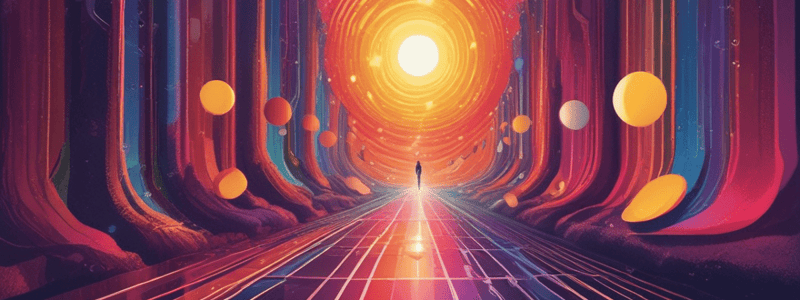Podcast
Questions and Answers
What is the main reason we can see colors in a forest on a sunny day?
What is the main reason we can see colors in a forest on a sunny day?
- Because of the presence of colorful flowers
- Because of the wavelength of the sun's light
- Because of the reflective property of tree bark
- Because of the way light interacts with matter (correct)
What is the term for the range of colors that we can see?
What is the term for the range of colors that we can see?
- Monochromatic colors
- Rainbow spectrum
- Electromagnetic spectrum
- Visible light spectrum (correct)
What happens to light when it bounces off an object that appears white?
What happens to light when it bounces off an object that appears white?
- It is refracted through the object
- It is reflected off the object (correct)
- It is transmitted through the object
- It is absorbed by the object
What is the complete spectrum of light that the sun gives off?
What is the complete spectrum of light that the sun gives off?
What is the reason why we see an object as black?
What is the reason why we see an object as black?
What determines the wavelength of light?
What determines the wavelength of light?
Is white considered a color in terms of wavelength?
Is white considered a color in terms of wavelength?
What happens to the atoms in an object when they absorb light energy?
What happens to the atoms in an object when they absorb light energy?
What is the term for objects that allow large amounts of light to pass through them?
What is the term for objects that allow large amounts of light to pass through them?
What determines the color of an object?
What determines the color of an object?
Why do leaves appear green?
Why do leaves appear green?
During autumn, why do leaves change color?
During autumn, why do leaves change color?
Why can't you mix all the colors of paint to make white?
Why can't you mix all the colors of paint to make white?
What is the reason why white objects appear to glow?
What is the reason why white objects appear to glow?
Which color reflects the most light?
Which color reflects the most light?
Flashcards are hidden until you start studying
Study Notes
White Light Colors
- Colors are specific wavelengths of light reflecting off objects, or matter, that humans can see.
- White light of the sun contains all the colors of the rainbow, which can be split into the visible light spectrum using a prism.
- The visible light spectrum consists of red, orange, yellow, green, blue, and violet (or purple) colors.
Electromagnetic Spectrum
- The electromagnetic spectrum includes the visible light spectrum, as well as wavelengths of light we can't see, including x-rays, UV light, infrared light, microwaves, and short and long radio waves.
Is White a Color?
- White is not a color in the classical sense, as it is not a single wavelength of light.
- Instead, when we perceive an object as white, we are seeing all the colors on the visible light spectrum bouncing off the object and hitting our eye, which our brain then names as "white."
- Black objects, on the other hand, absorb all the colors of the light spectrum, while pink is a mixture of red and violet light.
Color Absorption and Reflection
- When light hits matter, it is either absorbed or reflected, or a combination of both.
- The frequency and wavelength of light are inversely proportional, meaning that when the wavelength is higher, the frequency is lower, and vice versa.
- Atoms in an object absorb light energy if the frequency of the light is the exact amount of energy needed to go from a grounded state to an excited state.
- If the energy is too large or too small, the light energy is reflected, resulting in the color we see.
The Rose Example
- When white light hits a red rose, the rose appears red to our eye because the orange, yellow, green, blue, and violet light is being absorbed by the rose petals.
- The leftover red light is reflected, making the rose appear red.
Objects and Light
- Opaque objects do not allow light to pass through, while transparent objects do, and translucent objects allow some light to pass through.
- When light passes through an object, it bends, or refracts, depending on the material.
What Determines the Color of Light?
- The molecular structure of an object determines what wavelength of light is reflected back to our eye and perceived as color.
- Pigments in an object determine which wavelengths of light are absorbed and reflected, and thus, determine the color of the object.
The Color Green
- Chlorophyll in leaves absorbs all wavelengths of visible light, except for green, which is then reflected back to our eye, making the leaves appear green.
Autumn Colors
- During autumn, the chlorophyll molecule in leaves breaks down, no longer absorbing red, orange, and yellow light, resulting in these colors being reflected and creating the autumn colors.
Making the Color White
- White is not created by mixing pigments, but rather by reflecting all the colors of the visible light spectrum.
- White objects have pigments that reflect all light, making them appear white to our eye.
What Color Reflects the Most Light?
- White is the "color" that is most reflective, as it has pigments that reflect all light.
Studying That Suits You
Use AI to generate personalized quizzes and flashcards to suit your learning preferences.




